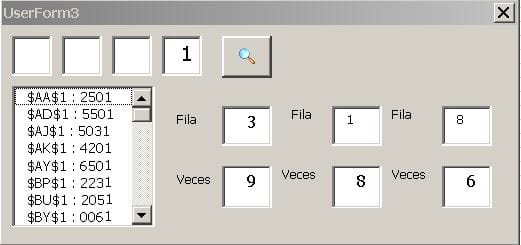Ya entendí tu petición, pongo otro ejemplo:

El código completo lo debes poner en tu userform:
Option Explicit
'
Dim numordenados As New Collection, llaves As New Collection
'
Private Sub CommandButton8_Click()
Dim r As Range, f As Range
Dim cell As String, t As String
Dim dic As Object, ky As Variant
'
t = IIf(Uno = "", "?", Uno) & IIf(Dos = "", "?", Dos) & IIf(Tres = "", "?", Tres) & IIf(Cuatro = "", "?", Cuatro)
Set numordenados = Nothing
Set llaves = Nothing
ListBox1.Clear
Filax = ""
Vecesx = ""
TextBox1 = ""
TextBox3 = ""
TextBox2 = ""
TextBox4 = ""
'
Set dic = CreateObject("Scripting.Dictionary")
Set r = Sheets("hoja1").Range("Z1:TW42")
Set f = r.Find(t, , xlValues, xlPart)
'
If Not f Is Nothing Then
cell = f.Address
Do
ListBox1.AddItem f.Address & " : " & f.Value
If Not dic.exists(f.Row) Then
dic(f.Row) = 1
Else
dic(f.Row) = dic(f.Row) + 1
End If
Set f = r.FindNext(f)
Loop While Not f Is Nothing And f.Address <> cell
End If
'
For Each ky In dic.keys
Call Addnum(dic(ky), ky)
Next
'
If numordenados.Count > 0 Then
Filax = llaves(1)
Vecesx = numordenados(1)
End If
If numordenados.Count > 1 Then
TextBox1 = llaves(2)
TextBox3 = numordenados(2)
End If
If numordenados.Count > 2 Then
TextBox2 = llaves(3)
TextBox4 = numordenados(3)
End If
End Sub
'
Sub Addnum(n, ky)
Dim m As Long
'Ordena números en una colección
For m = 1 To numordenados.Count
If numordenados(m) < n Then
numordenados.Add n, before:=m
llaves.Add ky, before:=m
Exit Sub
End If
Next
Numordenados. Add n
Llaves. Add ky
End Sub


